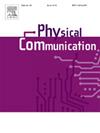Optimization of computational efficiency in IoT based on joint assistance of ARIS and UAV in MEC systems
IF 2
4区 计算机科学
Q3 ENGINEERING, ELECTRICAL & ELECTRONIC
引用次数: 0
Abstract
Unmanned Aerial Vehicle (UAV) and Reconfigurable Intelligent Surfaces (RIS) have emerged as transformative technologies in mobile edge computing (MEC), offering flexible deployment and intelligent signal manipulation to enhance data transmission. This paper proposes a novel architecture integrating mobile Active Reconfigurable Intelligent Surfaces (ARIS) with UAV to concurrently improve MEC model computation capacity and bidirectional task offloading/downloading channels. The goal is to maximize computational efficiency by balancing task bits and total energy consumption under constraints including computational resources, communication time/power, UAV trajectory optimization, and ARIS phase shifts. A hybrid algorithm combining Dinkelbach method, Lagrange multiplier approach, successive convex approximation (SCA), and semi-definite relaxation (SDR) is developed to solve the non-convex optimization problem. Simulation results demonstrate that the proposed scheme outperforms baseline methods in computational efficiency while maintaining an optimal balance between task processing volume and energy expenditure. This work provides a promising framework for future wireless-edge systems by leveraging UAV mobility and re-configurable intelligence.
基于ARIS与无人机协同协同的MEC系统物联网计算效率优化
无人机(UAV)和可重构智能表面(RIS)已经成为移动边缘计算(MEC)领域的变革性技术,提供灵活的部署和智能信号处理,以增强数据传输。本文提出了一种将移动主动可重构智能曲面(Active Reconfigurable Intelligent Surfaces, ARIS)与无人机相结合的新型体系结构,以提高MEC模型的计算能力和双向任务卸载/下载通道。目标是在计算资源、通信时间/功率、无人机轨迹优化和ARIS相移等约束下,通过平衡任务位和总能耗来最大化计算效率。提出了一种结合Dinkelbach法、Lagrange乘子法、逐次凸逼近(SCA)和半定松弛(SDR)的混合算法来解决非凸优化问题。仿真结果表明,该方案在计算效率上优于基准方法,同时在任务处理量和能量消耗之间保持最佳平衡。这项工作通过利用无人机的移动性和可重新配置的智能,为未来的无线边缘系统提供了一个有前途的框架。
本文章由计算机程序翻译,如有差异,请以英文原文为准。
求助全文
约1分钟内获得全文
求助全文
来源期刊

Physical Communication
ENGINEERING, ELECTRICAL & ELECTRONICTELECO-TELECOMMUNICATIONS
CiteScore
5.00
自引率
9.10%
发文量
212
审稿时长
55 days
期刊介绍:
PHYCOM: Physical Communication is an international and archival journal providing complete coverage of all topics of interest to those involved in all aspects of physical layer communications. Theoretical research contributions presenting new techniques, concepts or analyses, applied contributions reporting on experiences and experiments, and tutorials are published.
Topics of interest include but are not limited to:
Physical layer issues of Wireless Local Area Networks, WiMAX, Wireless Mesh Networks, Sensor and Ad Hoc Networks, PCS Systems; Radio access protocols and algorithms for the physical layer; Spread Spectrum Communications; Channel Modeling; Detection and Estimation; Modulation and Coding; Multiplexing and Carrier Techniques; Broadband Wireless Communications; Wireless Personal Communications; Multi-user Detection; Signal Separation and Interference rejection: Multimedia Communications over Wireless; DSP Applications to Wireless Systems; Experimental and Prototype Results; Multiple Access Techniques; Space-time Processing; Synchronization Techniques; Error Control Techniques; Cryptography; Software Radios; Tracking; Resource Allocation and Inference Management; Multi-rate and Multi-carrier Communications; Cross layer Design and Optimization; Propagation and Channel Characterization; OFDM Systems; MIMO Systems; Ultra-Wideband Communications; Cognitive Radio System Architectures; Platforms and Hardware Implementations for the Support of Cognitive, Radio Systems; Cognitive Radio Resource Management and Dynamic Spectrum Sharing.
 求助内容:
求助内容: 应助结果提醒方式:
应助结果提醒方式:


